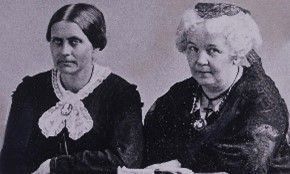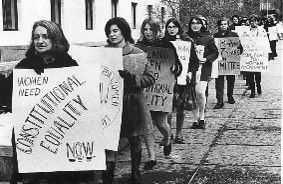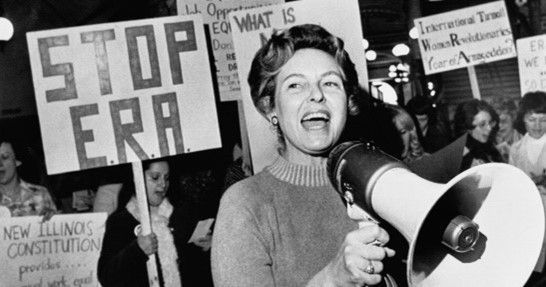Current Pro-Life Issues and Women’s Movement History
Planned Parenthood … Are They Killing and Harming Humanity?
Planned Parenthood wants you to believe they support parenthood, family planning and a woman’s choice in reproductive healthcare. They claim to provide “women’s reproductive healthcare”, and say their services are “essential”. Nothing could be further from the truth. Founder, Margaret Sanger and her friend, Larry Lader , (known as the father of abortion) have deep roots in eugenics. Planned Parenthood preys on minorities and
Equal Rights Amendment (ERA) Ratification – What it is, and what it isn’t
ERA may sound like it’s all about protecting women’s rights. Don’t be fooled! Women’s rights are already protected under the 14 th Amendment. ERA is better described as Everything Related to Abortion. Overturning of Roe v. Wade giveth abortion policy back to the states. ERA Ratification taketh away. ERA is the legal weapon to invalidate all state and federal limitations on abortion and have it written into the US
Chemical Abortion – A high profit procedure that puts women at risk
There is a notion that life’s challenges can easily be solved by conveniently popping a few pills. Abortion is no exception. Chemical abortion pills, terminates a pregnancy up to 70 days gestation (measured in number of days since a woman’s last menstrual period) As of 2020, 53% of all abortions performed in the US are chemical. In Maine, as of 2021, 60% of reported abortions are chemical. Women should beware of the risks.
The Hyde Amendment – Designed to Reduce Taxpayer Funded Abortion.
Nearly three quarters of Americans object to the taxpayer funding of abortion. According to a recent Knights of Columbus/Marist Poll , 81% of Americans believe that laws can and should protect the mother and her unborn child. Laws matter! In 1970, Title X of the Public Health Service Act established the National Family Planning Program within the U.S. Department of Health & Human Services (HHS). The Title X program is
History of Pro-life
Why the Pro-life Movement?
History of Contraception, Abortion, and Roe v Wade
There’s been a shift in law and attitude. Once upon a time, life in the womb was most sacred. Contraception was illegal. Abortion was a crime. Protecting the life of the unborn was paramount – a fetus was recognized as a human being with rights and opportunities to prosper.
The family took center stage.
In today’s altered society, our controlled narrative and laws couldn’t care less about the unborn, self-interest is paramount, gender has been deconstructed, and marriage re-defined, all in the name of equal rights.
Back in 1927, conception determined when human life began. The American Medical Association urged state legislatures to pass laws to protect the unborn. Every state passed laws that made abortion a serious crime.
History of the Pro-life Movement and Abortion
1873
The Comstock Act
Anthony Comstock, a devout Christian from New York City, observed his city teeming with prostitution and women being exploited. He believed contraception was lewd and immoral and promoted promiscuity. He went to Washington, DC, to do something about this.
The Comstock Act was passed in 1873 and known as the Anti-Obscenity Law, which prohibited the sale and possession of birth control. Information promoting birth control was deemed “Articles of immoral use.” Many states passed laws prohibiting the sale of contraceptives.
The Comstock Act Challenged - First Birth Control Clinic
1916
1920
American Birth Control League Founded
In 1920, The American Birth Control League (later to become known as Planned Parenthood) was founded.
Contraceptives Legalized
By 1936, the US Court of Appeals decision permitted doctors to distribute contraceptives across state lines, giving legitimacy to the birth control industry. This changed the public attitude on birth control. Once opposed, Christian Churches warmed to morally accepting birth control, though the Catholic Church remained opposed. Birth rates dropped significantly.
1916
1959
American Birth Control League Founded
In 1959, the American Law Institute proposed a model penal code for state abortion laws. This code advocated legalizing abortions in limited circumstances, to include the mental & physical health of the mother, rape and incest, and fetal deformity. Colorado was the first state to pass an abortion law permitting abortion under these limited circumstances. California, Oregon, and North Carolina followed suit.
National Right to Life Founded
As more states embraced pro-abortion laws, the National Right to Life movement was founded in 1968 in an effort to organize, communicate, and coordinate what was going on in various states across the country.
1968
1973
Legalized Abortion on Demand
By the early 1970s, four states had laws making abortion on demand legal; one state permitted abortion for rape or incest; a total of 31 states had very limited laws permitting abortion, only to save a mother’s life.
Then, the federal government stepped in. Contrary to what people think, Roe V. Wade is not a law passed by Congress on January 22, 1973. It was a vote by 7 (a full court has 9) Supreme Court Justices. The US Supreme Court determined that all state laws protecting the unborn were null and void. Roe v. Wade ruled that “legal personhood does not exist prenatally.” This decision made abortion legal in all 50 states for the full term of pregnancy. To this day, this is the most controversial Supreme Court Decision.
Roe v. Wade Court Decision
Roe v. Wade is actually two cases – Roe V. Wade – Texas, and Doe V. Bolton – Georgia. The court read both together. Though Doe is rarely spoken about, in its nearly 40-year history, it is Doe that has the greatest impact on abortion policy. Doe provides what is called the “health exception” for an abortion after a fetus becomes viable. The “health exception” addresses the physical, emotional, psychological, familial, and age of the mother, thus providing legal justification to have an abortion throughout the entire gestational pregnancy.
The Doe decision distinguishes the US as one of the most liberal democracies in the world. Only seven countries allow abortion after 20 weeks. The US is one of four nations (Canada, China, and North Korea) that allow abortion for any reason after fetal viability.
Last September (2022), at a live national town hall debate at the National Constitutional Center in Philadelphia, “Should Roe V. Wade be overturned?” was addressed. Kathryn Kolbert – the pro-abortion lawyer who argued the 1992 Supreme Court case Planned Parenthood V. Casey (the court refused to overturn Roe), stated: “This court is prepared to overturn Roe and return the matter to the states.” A law professor on the panel nodded and added: “All of us assume the Court will overturn Roe.”
For the past 25 years, the hearts and minds of Americans have favored life over abortion. This is demonstrated in the decline in abortions throughout the US. The percentage of women having abortions today has dropped to 1972 levels (the year before the Roe V. Wade decision). According to the CDC, abortion rates are down in both pro-life and pro-abortion states by upwards of 30%.
Of Americans who identify as being pro-choice - two-thirds oppose late-term abortion. Seventy-nine percent of Americans oppose late-term abortions, and 82% of Americans oppose denying care to a viable child after birth.
“Disconnect With Public Opinion.”
A Gallup poll issued on January 22nd, 2020, titled: Dissatisfied with US Abortion Laws at a New High, reveals a 7% increase from a year ago. Today, 58% of Americans are not happy with our nation’s abortion laws and believe they should be stricter. This is a new high for Gallup’s trend.
The mainstream media controls a narrative that is not aligned with the thoughts of our nation. The powers that be portray pro-lifers as predominately white religious males who know nothing about the woman’s body – the true Pro-Life movement is a very diverse group that includes Pro-Life Democrats (who were told there was no place for them in the party), blacks and browns, atheists, Jews, secular, gays, and lesbians.
History of
Women’s Activism
How Women's Activism Started
Margaret Sanger was born into poverty but married into wealth. She is credited with starting Planned Parenthood. Learn more about Margaret Sanger's background.
Amid today’s labeling of white supremacists, bashing white men who know nothing about women’s health, and untenable sexual abuse and exploitation of women, it may come as a surprise to learn that legalized abortion was introduced, promoted, and advanced by Larry Lader –a
July 13, 1848, marks the very beginning of the Women’s Movement. On this day, housewife and mother Elizabeth Cady Stanton (1815-1920) gathered four women, including Lucretia Mott (1793-1889), for tea. Discontented over the limitations of women in America, Stanton was the only non-Quaker in the group. The women took action! Five days later, a convention was held at the Wesleyan Chapel in Seneca Falls, NY. Other than a small advertisement in the local newspaper, the event was barely publicized.
Stanton drafted The Declaration of Sentiments. Modeled after the Declaration of Independence, the Declaration of Sentiments stated, “All men and women are created equal.” The convention at Seneca Falls was held to discuss the social, civil, and religious rights of women, their grievances and demands, and a call to constitutionally guarantee women’s rights to equality as US citizens, which included the right to vote. This began the Suffrage movement. The declaration was signed by 68 women and 32 men and formalized the start of the Women’s Rights Movement in the US.
Trailblazers Unite

Stanton met Susan B. Anthony (1820-1906) in 1851. Anthony had seven brothers and sisters and, at a very young age, was inspired by the Quaker belief that everyone was equal under God. This belief was the foundation of her life’s work. She became an activist, uninhibited by social rules that women shouldn’t speak publicly; she passionately delivered speeches against slavery. Stanton and Anthony became friends and spent the next 50 years fighting for women’s rights. Together, they co-founded the American Equal Rights Association and, in 1868, published The Revolution –a publication that promoted equality and rights for women.
Education and political rights were considered privileges of the upper class, but the voices of the Movement also included non-white ordinary women. Sojourner Truth (1797 – 1883), a formerly enslaved person, became the voice that bridged the ordinary with the elite. Though she couldn’t read or write, she became a charismatic speaker against the evils of slavery. When she met Elizabeth Cady Stanton and Susan B Anthony, she joined the women’s Movement, delivering her famous speech: “Ain’t I a Woman,” where she challenged racial and gender inferiority and inequality.
Temperance, Abolition, and Suffrage
Temperance, abolition of slavery, and women’s rights were the social issues of the time. Many courageous women became activists, taking to the lecture circuit in the 1860s and 1870s. They held popular and effective rallies. Some women activists had more than 200 speaking engagements a year. While they were focusing on suffrage, they were pushing for equal rights for women overall. In 1866, the American Equal Rights Association (AERA) was founded to “secure Equal Rights to all American citizens, especially the right of suffrage, irrespective of race, color, or sex.” Lucretia Mott was AERA’s president.
There wasn’t always agreement, and a schism occurred over the ratification of the 15th Amendment. Anthony and Stanton were against it because, in giving black men the right to vote, they believed the women’s right to vote should be included. They believed the two issues belonged together and should be fought at the federal level. They formed the National Woman Suffrage Association (NWSA). Opponents believed the immediate expansion of citizenship rights to formerly enslaved people would be jeopardized by including voting rights for women; they believed women’s suffrage should best be achieved through amendments to individual state constitutions. They formed the American Woman Suffrage Association (AWSA).
Towards Victory
The first victory in voting rights came in 1869 when Wyoming Territory granted women the right to vote. Both women’s organizations celebrated the victory. Then, in 1878, the NWSA successfully lobbied the US Congress for a constitutional amendment. Though Congress formed committees in the House of Representatives and the Senate to study and debate the issue, when the proposal reached the Senate floor in 1886, it was defeated. By 1890, the two organizations merged, forming the National American Woman Suffrage Association (NAWSA). Their strategy was to lobby for voting rights state-by-state.
New Faces, New Challenges
By the turn of the 20th century, four states passed voting rights to women, and women’s suffrage was gaining momentum. Despite the deaths of Stanton (1902) and Anthony (1806), young energy entered the Movement. Stanton’s daughter, Harriot Stanton Blatch (1856-1940), raised awareness with parades, pickets, and marches. Alice Paul (1885-1977) brought a discipline strategy with a militaristic style.
Unfettered, she organized marches, White House protests, and rallies. She founded the Congressional Union for Woman Suffrage (which later became the National Woman’s Party), was arrested several times, and imprisoned at least three times; she was the key leader in securing the passage of the 19th Amendment in 1920. The 19th Amendment reads: “The right of citizens of the United States to vote shall not be denied or abridged by the United States.” This put an end to a nearly century-long fight to prohibit sex discrimination in the right to vote.
Once they secured the right to vote, Paul and members of the National Woman’s Party decided to seek constitutional guarantees of equality by way of the Equal Rights Amendment, written by Paul and Crystal Eastman (1881-1928) and delivered to Congress in 1923. It read: “Men and women shall have equal rights throughout the United States and every place subject to its jurisdiction. In 1943, the wording was changed to the version that exists today. It reads: “Equality of rights under the law shall not be denied or abridged by the United States or by any state on account of sex.”
Beyond Suffrage: The ERA Challenge
Like the disagreement on suffrage, a bitter split emerged with ERA when some of Paul’s allies in suffrage found ERA troubling. The challenge was to ensure that equal rights match women’s needs. At conflict was the goal to allow women to have the same opportunities as men while, at the same time, enabling women to be freely distinct and different from men without adverse consequences. This challenge remains today and is why, though the ERA passed Congress in 1972, the ERA has never been ratified.
The Shifting Tide in the 1960s
A new wave of feminism was taking shape in the 1960’s. Though women had the right to vote, could hold public office, and had equal employment opportunities, the obvious differences between men and women were overlooked. The importance of protecting women and families, including 24-hour childcare for working families, was cast aside for a new order. The birth control pill was approved by the FDA, over-population, fear of famine, and the sexual revolution took the eye off family, with a new focus on the individual and a belief that the government would come up with all of the solutions.
A new emerging leader, Smith College graduate Betty Friedan (1921-2006), surveyed fellow college graduates for her 15-year reunion and concluded women were unhappy with their lives as housewives. In 1964, she published The Feminine Mystique, which became a best seller. Friedan uncovered “the problem with no name.” Though women were married with children and living in comfort, women were unhappy. Magazines, educators, and advertisers narrowly promoted the domestic sphere, a stark contrast to the 1930s, when magazines featured confident, independent career women. According to her survey, women felt they had lost their identity.

Friedan’s book propelled the rethinking of femininity and sparked the sexual revolution, spinning the women’s Movement in several different directions. The National Organization for Women (NOW) was organized in 1966, and Friedan drafted the founding statement, emphasizing women’s need for identity and autonomy - women as human beings must be given a chance to develop to their full potential, at the 1967 NOW conference at the Mayflower Hotel in Washington, DC. A clash of the liberation movement with the radical feminist Movement came to a head when Betty Friedan shocked members by pressing a vote for a full repeal of all abortion laws. By the end of the meeting, one-third of NOW’s members quit.

In 1969, the narrative, focus, and language shifted within the Women’s Rights Movement– not by women,
but by two men who co-founded
NARAL (National Association for the Repeal of Abortion Law) with the support and advocacy of Betty Friedan.
Lawrence Lader, a journalist, and
Dr. Bernard Nathanson (1926-2006) were clever.
The narrative had changed, and now, Friedan advocated that legalized abortion changed and now, Friedan advocated that legalized abortion and contraception was advancing women’s reproductive healthcare. The
Women’s Movement was hijacked. Lader is credited as being the
founding father of the abortion movement and heavily influenced the Roe V. Wade decision in 1973.
The Current Landscape
Today, abortion defines the women’s Movement. This is not what the pioneers of the women’s Movement had in mind. Elizabeth Cady Stanton wrote: “When we consider that women are treated as property, it is degrading to women that we treat our children as property to be disposed of as we see fit.”
Victoria Woodhull, the first woman candidate for president, wrote: “Every woman knows that if she were free, she would never bear an unwished-for child, nor think of murdering one before its birth.”
The first woman to receive a medical degree in the US, Elizabeth Blackwell, wrote: “The gross perversion and destruction of motherhood by the abortionist filled me with indignation and awakened active antagonism.”
Susan B Anthony’s The Revolution published a piece that said abortion was a choice that would burden both a woman’s “Conscience in life and soul in death,” which ultimately is an exploitation of women.
At Maine Right to Life, we follow our early leaders with a shared belief that the rights of mother and child are inherently linked. By getting to know our early leaders, we admire their courage, are inspired by their persistence, and we feel called to carry the torch to protect the authentic lives of women and children.
History of the
Women’s Movement
How the Women's Movement Started
Motherhood is a divine privilege that must be protected because our existence depends on women! Women are the bearers of life. They have a womb and are biologically designed to nourish and nurture new life, giving birth to the world.
The founders of the women’s movement wanted to be admired and respected for their womanhood and their equal brain matter. They did not say that to be equal to men, women must reject their femininity. They never envisioned a world where the right to vote would be displaced with the slavery of abortion, and worse, sugar-coated to look like freedom, autonomy, and equality – packaged and sold as “women’s reproductive healthcare.”
Abortion: A Man's Control Over Women
No! Women are being sold down the river, just like the enslaved people before them. Abortion is man’s ultimate control over a woman’s ability to birth and raise children. The women of Betty Friedan’s generation never realized men were and still are dictating who has children and who does not. Betty herself was steered off course by journalist and friend Larry Lader, who convinced Betty his agenda - overpopulation - could sell abortion. It was Lader who developed the language: A woman should have the right to control her own body. The women’s movement was hijacked by a white man whose agenda was population control.
Preserving Authentic Gender Equality
To be a woman doesn’t mean that every woman should become a mother, nor should every man become a father. Gender defines biologically who we are and who we are not. Authentic gender equality should respect and protect what makes women different. But this isn’t happening.
Gender Equality Challenges
Today, gender equality is being defined as being one and the same, when biologically, we know this is not true. The age of gender fluidity is exploiting women. Recently, three high school track stars from Connecticut (biologically female) sued because two transgender students, identifying as girls but with male anatomy, deprived the girls of honors and opportunities for scholarships. Can you guess who is being vilified? … The girls.
What has been misleading in the women’s movement is a false and unrealistic belief that a woman can do everything a man does. That very notion diminishes women worldwide. Sex selection, also known as gendercide, is happening. It is estimated that roughly 200 million baby girls have been intentionally aborted – why?... because they are girls.
Gendercide affects the sex ratio in society. A surplus of men causes violent social consequences. When there aren’t enough women to go around, women become an underclass. This puts them at risk of being stolen or sold into prostitution or marriage.
The late Phyllis Schlafly (1924-2016), housewife, mother of six, lawyer, and activist, may be best known for exposing ERA ratification for what it really is and bringing it down. ERA ratification was initially thought to be a symbolic bipartisan piece of legislation that would sail on through became a political lightning rod, yet to be ratified.
Phyllis Schlafly's Legacy

Phyllis Schlafly exposed the problems, took action, and engaged a grass-roots movement made up of inexperienced and unlikely activists: “Housewives,” as she explained, who “didn’t even know where their state capitol was.”
She founded STOP ERA, an acronym for Stop Taking Our Privileges, exposing the unintended consequences ratification posed: The stripping of gender roles, alimony, child custody, sexual assault protection, and single-sex restrooms, leading to taxpayer-funded abortions and the forced military draft of women. In fact, the ERA will wipe out laws already in place that protect women’s unique needs.
The ERA Initiative: Unveiling the Truth
We are seeing the problems unfold right now when biological men are transgender to women and rob biological women of sports recognition, titles, and scholarships. We see the risks to biological women when men choose to identify as women and gain access to women’s bathrooms, locker rooms, and female dormitories. ERA ratification doesn’t do what it is supposed to do: Protect Women for who they are and what their gender is designed to do – nurture, protect, and give the world new life. The women’s movement and ERA have both been hijacked.
Efforts to ratify the ERA were taken up again in 2019. “Equal Rights” sounds so fair and equitable, doesn’t it? Don’t be fooled, though; the ERA is a wolf in sheep’s clothing, and the new ERA ratification initiative should be dubbed Everything Related to Abortion.
Feminist for Life’s Perspective
Feminist for Life, President Serrin Foster believes that women deserve so much better, and something is seriously wrong when abortion (under the auspices of women’s reproductive healthcare) is prescribed to women who find themselves unexpectedly pregnant, overwhelmed, and lacking in support and resources. “Not only must we do better; women deserve better.”
We must ensure that ERA is not ratified in Maine, that biological women can compete fairly in women’s sports, and that women facing unplanned pregnancy have the support and resources to completely know all their choices.
Maine Right to Life believes we should follow the lead of the late Phyllis Schlafly and engage Maine citizens to not only find their way to the State Capitol but engage with their local lawmakers and ultimately change laws!
Maine Right To Life is a 501(c)3 Non-Profit Focused on Educating the People of Maine about Pro-Life Issues.
Learn About Us
MRTL News Sign Up
Contact Us
Thank you for contacting us.
We will get back to you as soon as possible.
Oops, there was an error sending your message.
Please try again later.







